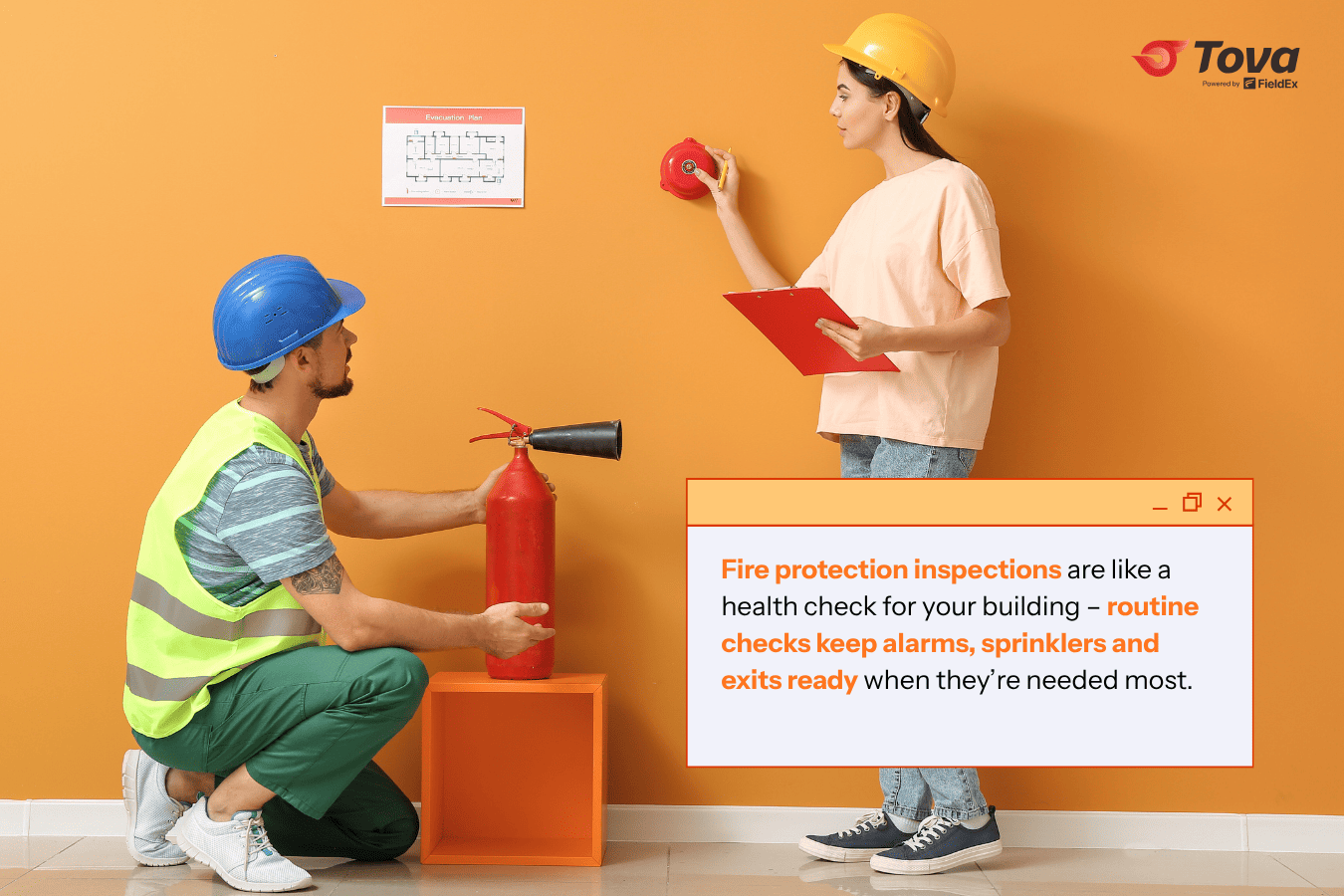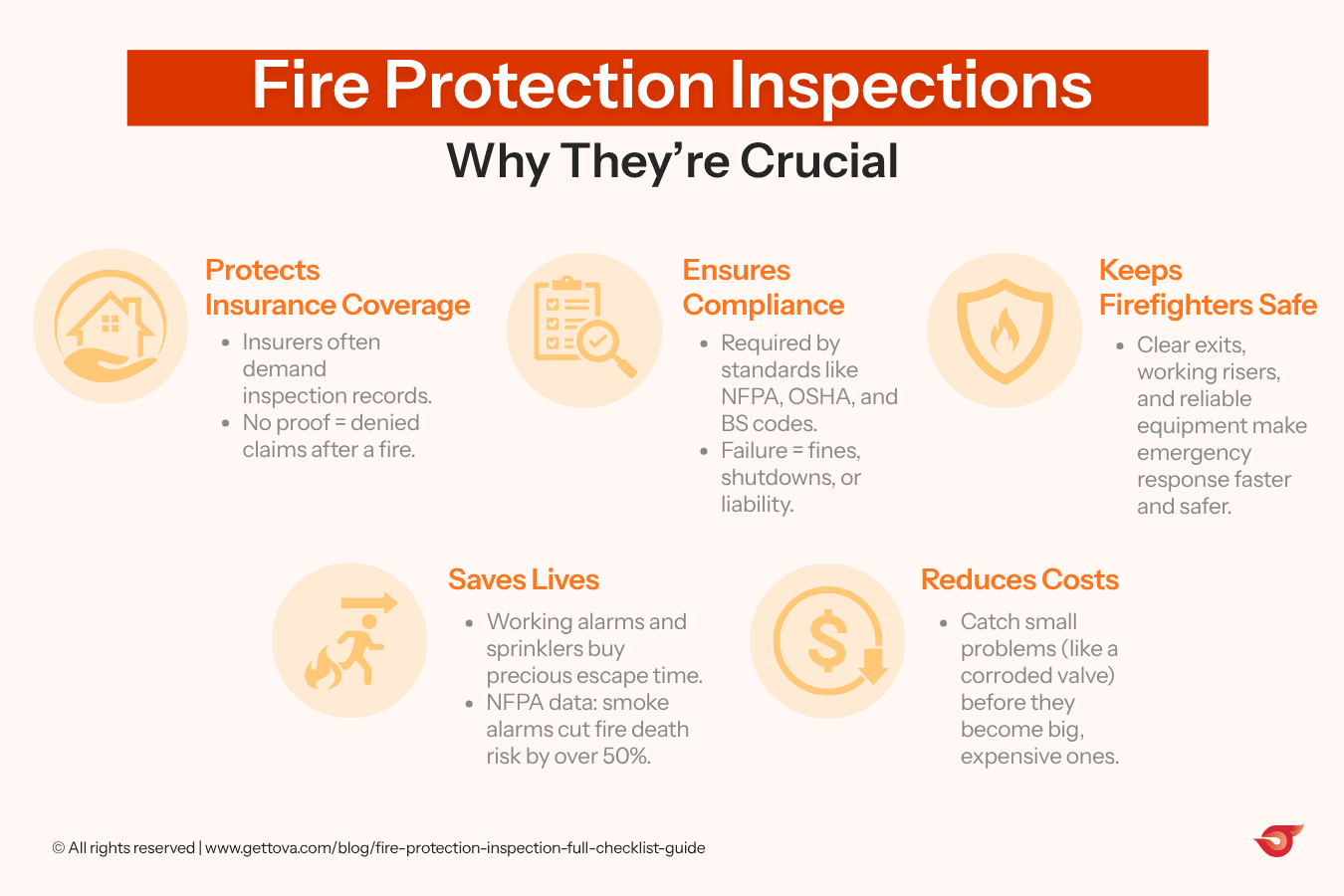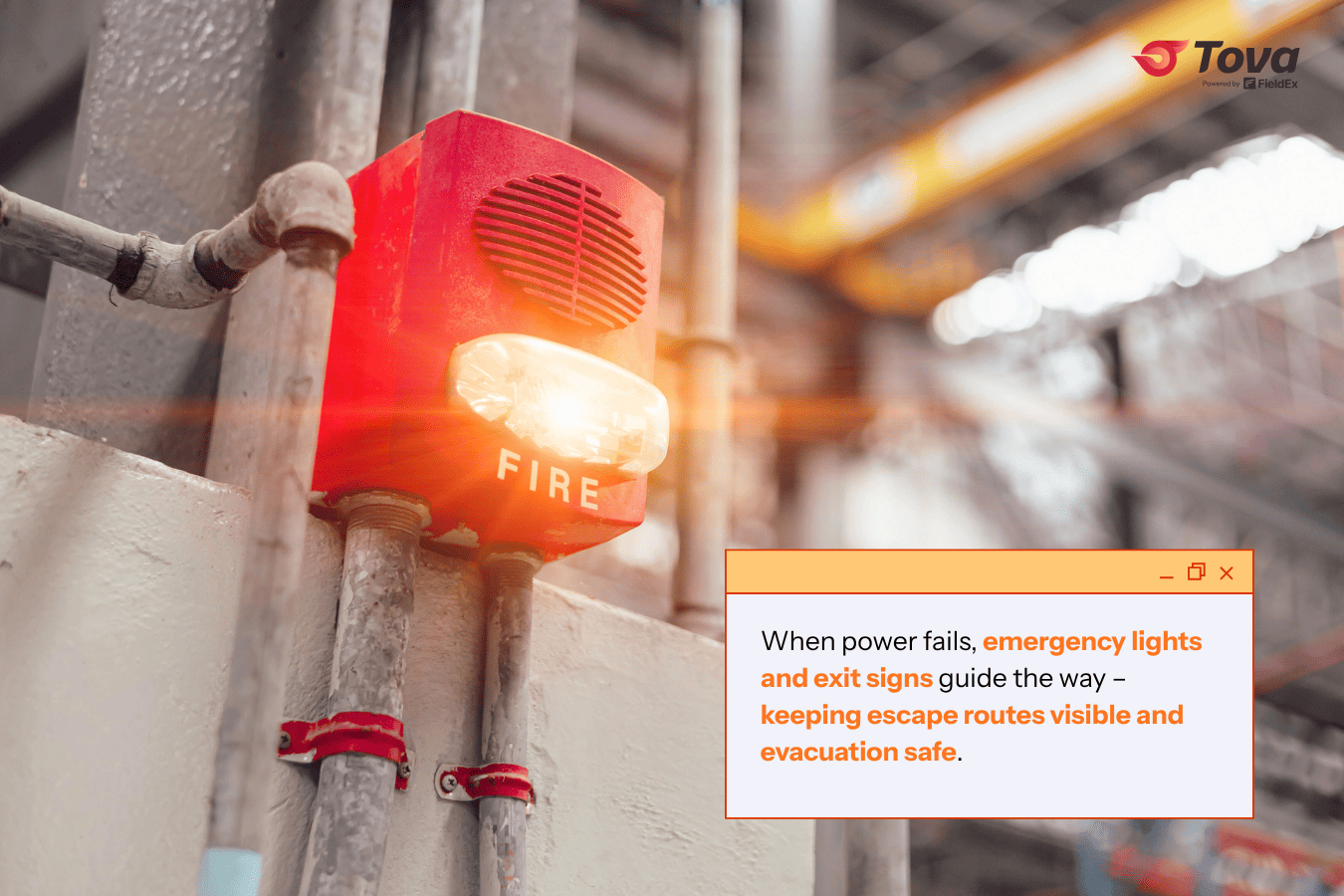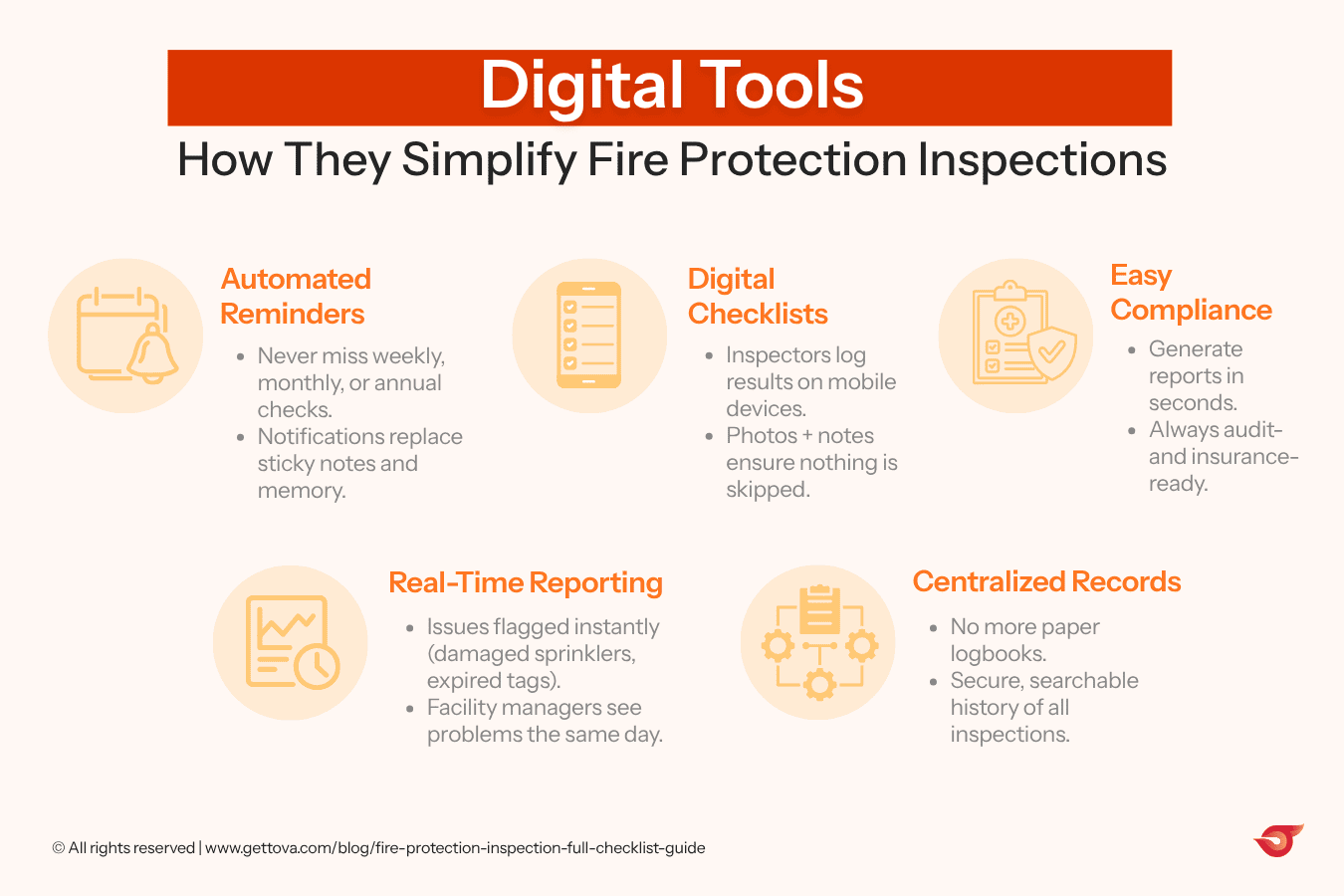
Quick question: When was the last time your fire protection systems had a proper checkup? Uhmm.. few weeks ago? Few months ago? Gaaawd, last year? Well, if you’re scratching your head, you’re not alone. Many building owners only think about fire alarms, sprinklers and extinguishers when an inspector shows up … or worse, after an emergency. (Yikes!)
A fire protection inspection is essentially a health check for your building’s safety systems. It makes sure everything (eg alarms, sprinklers, extinguishers, risers, emergency lights, special suppression systems) is working as it should. More importantly, it keeps you compliant with codes like NFPA, OSHA, BS and EN standards, which isn’t just about avoiding fines, it’s about saving lives.
In this guide, we’ll walk through what a fire protection inspection actually entails, the systems and equipment that need checking, and provide you with a full fire protection inspection checklist you can use to stay on top of compliance. By the end, you’ll know exactly what inspectors look for, and how to be prepared.
Y'all ready? Let's get started!
A fire protection inspection is, in essence, a ‘full-body checkup’ for your building’s safety systems. You wouldn’t ignore a warning light in your car, would you? So why gamble with alarms, sprinklers and extinguishers that may not work when you need them most?
In plain terms, this inspection is a systematic review of every fire safety measure in your facility. Inspectors don’t just glance at equipment; they test, verify and document whether systems meet code, are in good condition, and will actually work in an emergency.

If you’ve ever wondered what happens during a fire protection inspection, here are some examples:
In short: a fire protection inspection isn’t paperwork, it’s proof your systems are ready when lives depend on them.
Skipping a fire protection inspection is a bit like ignoring that “service engine soon” light on your dashboard. Sure, things might seem fine – for now. But when a fire breaks out, you don’t want to hope your systems work. You want to know they’ll respond. Here’s why these inspections aren’t just a box to tick:
The number one reason inspections matter? People. Properly maintained alarms, sprinklers and extinguishers buy precious time for occupants to escape. According to the NFPA, working smoke alarms reduce the risk of dying in a home fire by more than 50%. Regular inspections keep those alarms (and every other system) ready to save lives.
Every major standard, from NFPA 25 (sprinklers) to OSHA regulations and BS 5839 (fire alarms in the UK), requires inspections. Non-compliance doesn’t just bring fines; it can also shut down operations until corrections are made.
Imagine a fire occurs and your insurer discovers expired inspection records. Claims can be denied, and legal liability may land squarely on your shoulders. Inspection logs aren’t just paperwork, they’re financial protection.
A faulty valve or corroded pipe, if caught early, costs far less to fix than replacing an entire system after failure. Inspections help you spot small issues before they turn into disasters.
Blocked exits, broken risers or dead backup batteries don’t just endanger tenants, they put responding firefighters at risk too. Inspections ensure conditions are safe for everyone involved.
Bottom line: Fire protection inspections are the safety net that keeps lives, property and businesses intact.

A fire protection inspection is about more than just checking one piece of equipment; it’s a top-to-bottom review of every system designed to stop a fire from spreading. Here are the major systems that require routine inspections (and what inspectors actually look at):
In short: Inspections cover everything from smoke detectors to suppression cylinders. If it’s meant to protect people from fire, it’s on the checklist.
If you’re wondering what actually happens during a fire protection inspection, here’s the full checklist broken down by system. Use this as a guide to prepare your building, and to make sure nothing slips through the cracks.

Pro Tip: Keep digital records of each inspection item. It’s easier to track, audit and share with insurers and authorities when needed.
Here’s the truth: fire protection systems don’t all follow the same inspection schedule. Some need a quick weekly check, while others are only tested annually or even once every 5–10 years. Inspection frequency depends on the type of equipment and the standards set by codes like NFPA 25 (for sprinklers), NFPA 72 (for alarms) and BS 5839/BS 9990 in the UK.
Pro Tip: Most inspectors recommend keeping a digital calendar of inspections (eg weekly, monthly, annual, long-term) so nothing gets missed. Platforms like Tova can automate reminders and store reports for easy compliance.
Here’s a common misconception: people often assume that once a fire protection system is installed, the responsibility automatically falls to the fire department. Not true. The ultimate responsibility lies with the building owner or facility manager – but they’re not alone in the process.
Key takeaway: While multiple parties are involved, building owners carry ultimate responsibility for inspections and compliance. Everyone else, including managers, contractors and authorities, supports that responsibility.
Even the best fire protection systems can fail if they’re neglected. Inspections often reveal the same recurring problems – most of which are preventable with proper maintenance. Here are some of the most common red flags:
It sounds obvious, but inspectors regularly find fire exits blocked by furniture, storage boxes, or even locked doors. In an emergency, every second counts – blocked exits can be deadly.
Any one of these issues can make an extinguisher useless when it’s needed most.
These failures delay detection and alarm activation, putting lives and property at risk.
One faulty head can compromise an entire zone.
Inspection records are often missing, incomplete, or outdated. Without proper logs, it’s impossible to prove compliance to insurers or authorities.
Takeaway: Most inspection issues are not catastrophic equipment failures; they’re everyday oversights like blocked exits or expired tags. Regular checks and preventive maintenance keep these problems from piling up.
.png)
Let’s be honest here ... traditional fire protection inspections can be a paperwork nightmare. Logbooks get misplaced, inspection tags fade and spreadsheets don’t always cut it when an auditor asks for proof. That’s where digital inspection tools step in, making the process faster, easier and far more reliable.
Instead of relying on sticky notes or memory, digital platforms can automatically remind facility managers when it’s time for weekly, monthly or annual checks. Nothing gets overlooked.
Inspectors can use mobile checklists to verify detectors, extinguishers, risers and sprinklers, all while logging notes and photos. This ensures every item on the fire protection inspection checklist is covered.
Inspection results can be uploaded instantly. If a sprinkler head is damaged or an extinguisher is missing, managers see it right away and can schedule repairs.
Instead of digging through binders, you can generate full inspection reports in seconds – ready for insurers, fire marshals or audits.

With Tova, fire safety teams can:
Bottom line: Digital tools take the hassle out of inspections, reduce human error, and give you peace of mind that your fire protection systems are always compliant and ready to perform.
A fire protection system is only as good as its last inspection. Sprinklers, alarms, extinguishers and risers might be installed, but without regular checks, you can’t be sure they’ll work when lives depend on them.
A proper fire protection inspection checklist goes beyond compliance – it ensures your building is safe, your insurance is valid, and your people are protected. The truth is, most inspection failures aren’t from faulty technology; they come from missed tests, expired tags or overlooked maintenance. That’s why consistency matters as much as the equipment itself.
The good news? Staying compliant doesn’t have to be a headache. With digital tools like Tova, you can:
Fire protection inspections aren’t just red tape – they’re your safety net. Keep them regular, keep them thorough, and your systems will be ready when you need them most.
It covers a full review of fire alarms, sprinklers, extinguishers, risers, emergency lighting, and suppression systems to ensure they work and meet code requirements.
Certified fire safety contractors typically perform official inspections. Facility managers may handle weekly or monthly checks, while fire marshals or AHJs conduct compliance audits.
They protect lives, keep you compliant with standards like NFPA 25 and NFPA 72, reduce liability, and catch small issues before they become major failures.
You may face violation notices, fines, insurance claim denials or even business shutdowns until issues are corrected.
Yes. Extinguishers must be visually checked monthly and undergo a full inspection annually. Gauges, seals, tags and condition are all reviewed.
Yes. Most countries mandate alarm inspections under standards like NFPA 72 (US) or BS 5839 (UK). Skipping them is a legal and safety risk.
Absolutely. Platforms like Tova offer digital checklists, automated reminders, and instant compliance reports, making inspections easier and more reliable than paper logs.

.avif)